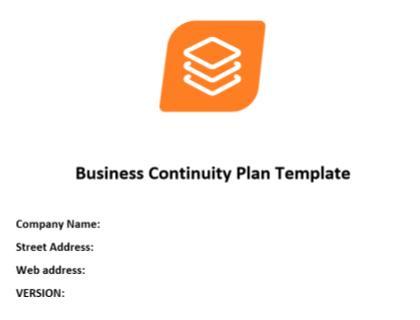COVID-19 (Coronavirus) Business Continuity Plan
A 7-step guide to creating a business continuity plan for dealing with COVID-19.
Updated on June 25th, 2023
The SMB Guide is reader-supported. When you buy through links on our site, we may earn an affiliate commission. Learn more
A business continuity plan (BCP) is a strategic plan a business would follow to prevent and recover from major disruptions to business. Typically, businesses establish a continuity plan for natural disasters, such as floods, arson, and terrorism.
The COVID-19 (Coronavirus) outbreak presented businesses with many unforeseen challenges due to its fast spread, global reach, and resulting lockdowns. This guide was created to help businesses modify and improve their business continuity plans during this time to be better prepared for the effects of the pandemic.
COVID-19 Business Continuity Plan Template
Use our general business continuity plan in Word format to help stay on task.
How to Prepare for COVID-19:
1. Prioritize your employees' safety.
The well-being and health of your employees should be your top priority. Start by addressing the needs of employees who display COVID-19 symptoms. To keep your entire team safe, send any employees with flu-like symptoms home. In this scenario, ensure you maintain transparent communication with all your employees, as this will go a long way in reassuring them.
Look into remote working solutions. To do this, you'll need to determine if you have the tools, technology, and capacity to support a small or large remote team. In addition, you might need to consider introducing or expanding flexible work arrangements. Depending on your type of business and industry, businesses may also need to reorganize teams and reallocate resources.
One of the adjustments businesses have to make is to implement infection protection measures. You need to create a strategy that enables employees to continue to work without endangering them. You can do this by establishing employee well-being programs and policies that support a safe working environment.
2. Identify the risks and impact of COVID-19.
As a business, it's vital that you stay updated on the latest news and regulations put into place by government officials. This also provides you with more information to help identify the risks and overall impact COVID-19 will have on your business.
The following are possible impacts that businesses should consider:
Employees may be unable to travel to work due to travel restrictions put into place. For employees that make use of public transport, the risk of infection is much higher due to close contact with other individuals. Additionally, since schools are officially closed, many parents may be unable to attend work due to childcare issues.
Employees may be prohibited from attending work. In the case of national shutdowns, employees will be unable to enter workspaces.
A visible slowdown in sales. During a national shutdown, customers will be unable to purchase services and products, which will lead to a rapid decrease in sales.
Additional costs for hiring temporary employees. Depending on the type of business or industry you're based in, you may need to continue work during a national shutdown. This will generally require essential employees only and if essential employees are diagnosed with COVID-19, you will need to consider hiring temporary employees.
Diminished workforce performance. If your employees are forced to work remotely but do not have access to the same quality of resources and technology, you could see a decrease in productivity.
Additional cost of establishing a remote workforce. As mentioned above, you may need to put resources in place to help employees maintain the same level of functionality. However, this will cost your business as employees might require special equipment, communication devices, and software.
Your business might be forced to close down. If your business does not provide essential services and cannot afford a remote workforce, you will have to close down during lockdowns. This could result in unpaid time off, especially for businesses like restaurants, salons, and bars.
3. Establish open and transparent communication.
Employees will look towards their community leaders, government officials, and employers for guidance during these uncertain times. Therefore, it's important that you encourage open dialogue with your employees and be as transparent as possible.
Leave as little to interpretation as possible. Employees will expect clear and straightforward steps that they can follow. When setting up your continuity plan, consider the diverse perspectives of your employees and which communication platforms will best suit their needs. This will help you determine how detailed your plan should be.
Establish a communications plan that provides employees, senior management, customers, suppliers, and government regulators with regular updates. Make sure your updates stem from verifiable news sources, such as the Centers for Disease Control and Prevention (CDC) and the World Health Organization (WHO).
4. Reshape your business plans for continuity purposes.
As the impact of COVID-19 continues to reshape the way businesses operate, it's critical that you review existing business plans, including your current business continuity plan and business disaster recovery plan.
To help address the COVID-19 challenges, businesses should:
Monitor direct cost escalations. This should also include the COVID-19 impact on overall product margins, which may require businesses to renegotiate terms and conditions where necessary. Businesses may be vulnerable to financial stress and long-term implications if they are slow to react.
Consider alternative supply chain options. If your business needs to source products or materials but the supplier is based in areas significantly affected by COVID-19, consider looking for alternative options. Remember to maintain active communication with all suppliers.
Identify how the COVID-19 pandemic impacts budgets and business plans. Start by conducting assessments with multiple scenarios to understand the potential impact on your business's overall performance. After detailing how long the impact is expected to last, and how it affects suppliers and budget predictions, revise your business's plans.
Look into alternative funding. Many businesses will face the issue of short-term capital demands. Based on your findings from the business plans assessment, you might need to look at near-term capital raising, short-term liquidity, debt refinancing, or additional credit support from banks, partners, or investors.
5. Prioritize key business functions and processes.
Start by identifying the key products and services your business provides, as well as the customers they're delivered to. This will help determine which high-risk areas are vulnerable, outline dependencies, and estimate the potential financial losses your business may face. Then, prioritize which business functions require additional attention.
6. Make use of support policies and funding.
Across the U.S., local governments and organizations have implemented several financial, social insurance, and tax-related policies to help support small businesses during this time. It is important to note that government support may differ based on your location and industry.
Monitor nationwide government and business opportunities that could support your business during this period. For example, the Small Business Administration (SBA) is providing low-interest working capital loans to small businesses and non-profit organizations.
7. Review and revise your business strategy.
Once the COVID-19 pandemic is controlled, you should consider reshaping your entire business strategy. This should include an assessment of all plans, including marketing, communications, and BCP. Your current revision will be done quickly and somewhat under duress as the situation continues to change dramatically.
If your assessment reveals any deficiencies, you will need to identify:
- Root causes.
- Timeliness of action.
- Lack of infrastructure.
- Labor shortages.
- External environment issues.
Once this is complete, consider putting new internal guidelines, plans, and policies in place based on the lessons learned. This will help you better respond to future crises and pandemics.
What is a Mission Statement?
Learn what makes a Mission Statement unique, and how to write one. Includes frequently asked questions about Mission Statements.
Mar 4, 2022
FAQs:
What is included in a COVID-19 business continuity plan?
- Policies that address various types of natural disasters.
- Processes that must be followed during this time.
- Guidelines that detail the business processes, assets, human resources, business partners, and more.
- An outline of the risks the business faces and how it will impact operations.
- Safeguards and processes to help mitigate the risks.
How do I prepare my business for COVID-19?
- Prioritize your employees' safety.
- Identify the risks and impact of COVID-19.
- Establish open and transparent communication.
- Reshape your business plans for continuity purposes.
- Prioritize key business functions and processes.
- Make use of support policies and funding.
- Review and revise your business strategy.
Where can I find a COVID-19 business continuity plan template?
Download our COVID-19 business continuity plan template for free.


